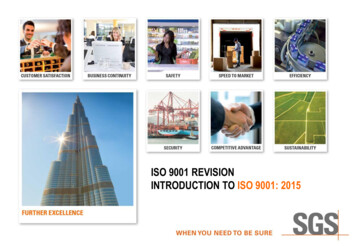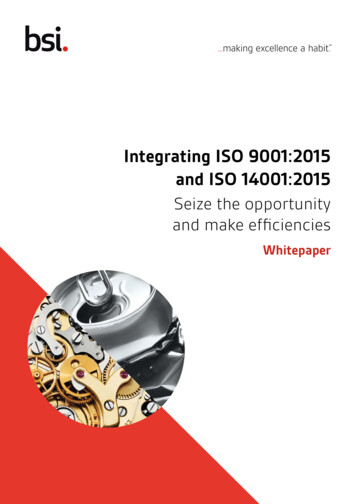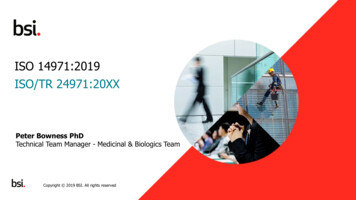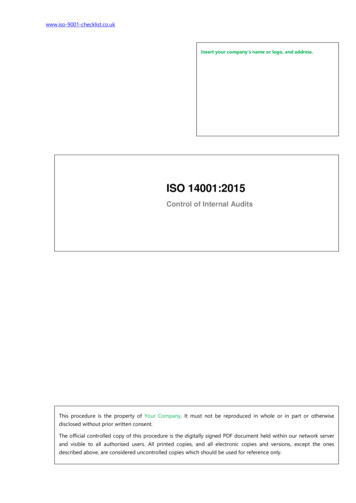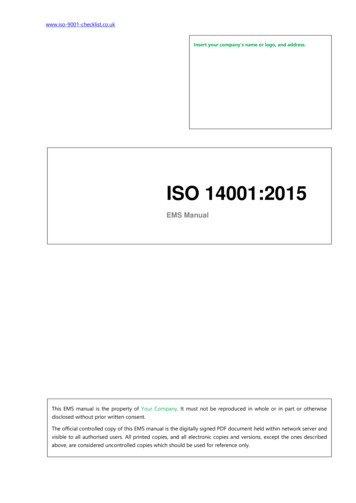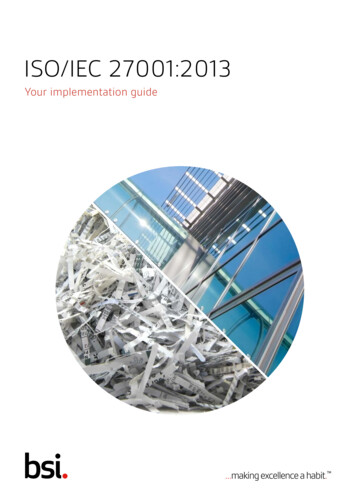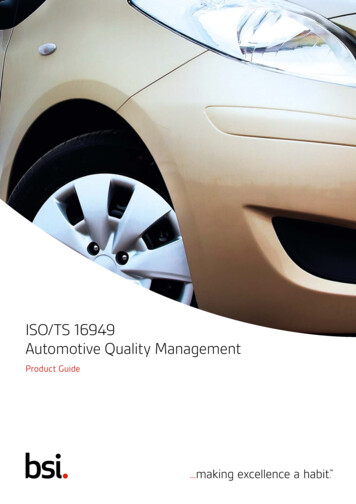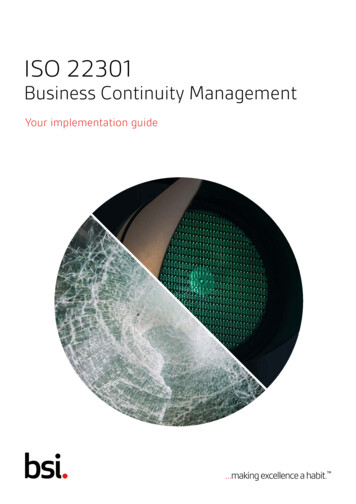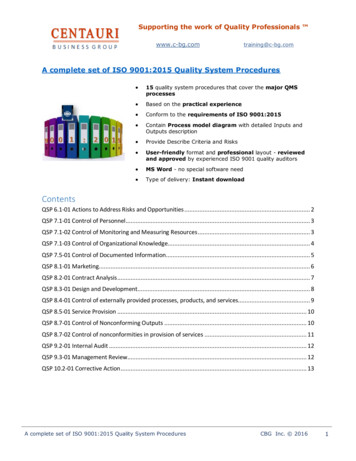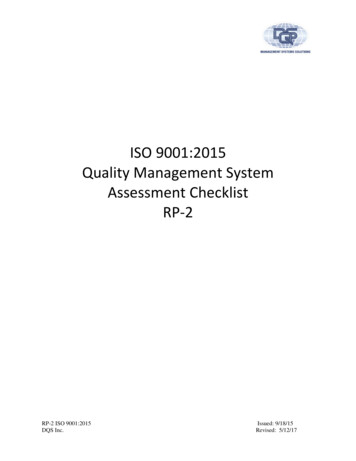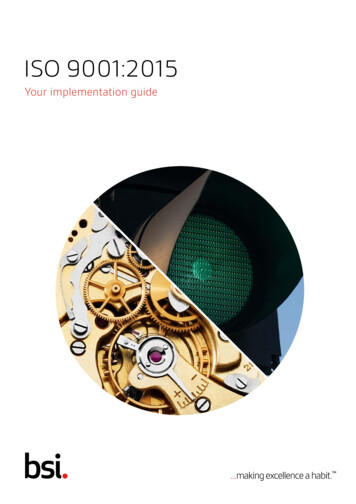
Transcription
ISO 9001:2015Your implementation guide
ISO 9001 is the world’s most popularmanagement system standardUpdated in 2015 to make sure it reflects theneeds of modern-day business, ISO 9001 isthe world’s most popular quality managementstandard. It’s an excellent framework to helpmanage your business effectively so that you canbe operationally resilient, build long-term success,and ensure customer satisfaction. It’s suitable forbusinesses of all sizes – from manufacturing toservice providers – and it’s designed to be reallyflexible so you can make it work for the needsof your business and continually improve.At BSI we have the experience to help make surethat you get the most from ISO 9001, in fact it wasour experts who helped shape the standard in thefirst place.This guide shows you how to implementISO 9001 in your business and get the most outof it for the long term. We also showcase ouradditional support services, which help you notonly achieve certification, but unlock furtherbusiness improvements after certification.“ The new version of thestandard has been incrediblyuseful to us.”Mark Kennedy, Programme Director, SalusContents 2B enefitsISO 9001:2015 clause by clauseTop tips from our clientsYour ISO 9001 journeyBSI Training AcademyBSI Business ImprovementSoftware
How ISO 9001 works and what itdelivers for you and your companyISO 9001:2015 is the new business improvement tool that helps drive continual improvement and deliverresults in your organization. It helps your business stand out, gain a competitive edge, and grow.It’s more than a quality management system, it’s a complete operational tool designed to improveperformance. It uses a process approach to ensure customer satisfaction and places quality right at theheart of your organization, complementing business strategy and helping enhance performance over time.This has been designed with the needs of modern businesses in mind. It provides a framework which helpsyou to focus on ensuring you anticipate your business environment and customer needs. It’s flexible andagile so you can make it work for your business. That’s how ISO 9001 really adds value.Benefits of ISO 9001*Better products and services66%Improving yourproducts and services60%Reducing the likelihoodof mistakesBetter for business65%Inspiring trust inyour business54%*Source: BSI Benefits survey - BSI clients were asked which benefits they obtained from ISO 9001:200857%Attracting newcustomersIncreases yourcompetitive edge3
How ISO 9001 worksISO 9001 was revised in 2015 to bring it up to date with the needs of modern businesses and to add even morevalue. It’s based on the high level structure (Annex SL) which is a common framework for all new managementsystem standards. This helps keep consistency, align different management system standards, offer matchingsub-clauses against the top-levelanagement SOrganization andstructure and apply common languagelity MysteQ uamits context (4)(4)across all standards. It makes it easierSupportfor organizations to incorporate their& Operationquality management system, into core(7,8)business processes, make efficiencies,PlanDoand get more involvement from shipPlan-Do-Check-Act (PDCA) is theoperating principle of ISO 9001. It’sapplied to all processes and the QMSas a whole. This diagram shows howClauses 4 to 10 of ISO 9001 canbe grouped in relation to PDCA.(6)evaluation(9)(5)ActNeeds andexpectations of relevantinterested parties (4)OutcomesCheckImprovement(10)Some of the core concepts of ISO 9001:2015 are:4ConceptCommentContext of the organizationConsider the combination of internal and external factors and conditions that can have aneffect on an organization’s approach to its products, services, investments and interestedparties.IssuesIssues can be internal or external, positive or negative and include conditions that either affector are affected by the organization.Interested partiesA person or organization that can affect, be affected by, or perceive themselves to be affectedby a decision or activity. Examples include suppliers, customers or competitors. You may referto them as stakeholders.LeadershipRequirements specific to top management who are defined as a person or group of people whodirects and controls an organization at the highest level.Risk associated with threatsand opportunitiesRefined planning process replaces preventive action and is defined as the ‘effect of uncertaintyon an expected result’.CommunicationThe standard contains explicit and detailed requirements for both internal and externalcommunications.Documented informationThe meaningful data or information you control or maintain to support your QMS.Performance evaluationThe measurement of quality performance and the effectiveness of the QMS, covering themethods for monitoring, measurement, analysis and evaluation, as applicable, to ensure validresults.Nonconformity andcorrective actionEvaluation of nonconformities and correct actions.Management reviewWill need to be carried out, with requirements relating to inputs and outputs of the review.
Key requirements ofISO 9001:2015Clause 1: ScopeThe first clause details the scope of the standard.Clause 2: Normative referencesISO 9000, Quality Management System Fundamentals and vocabulary is referencedand provides valuable guidance.Clause 3: Terms and definitionsAll the terms and definitions are contained in ISO9000:2015 – Quality Management – Fundamentalsand vocabulary.Clause 4: Context of the organizationThis clause establishes the context of the QMS andhow the business strategy supports this. “Contextof the organization” is the clause that underpinsthe rest of the standard. It gives an organizationthe opportunity to identify and understand thefactors and parties in their environment thatsupport the QMS.The starting point is to identify all external andinternal issues relevant to your QMS. Then youneed to establish all “interested parties” and howthey are relevant to your QMS. You might referto them as stakeholders. You will also need todecide on the scope of your QMS. This may be thewhole of your organization or specific, identifiedfunctions.Finally, by using the process approach, you’llneed to show how you establish, implement,maintain, and continually improve the QMSin relation to the standard.Clause 5: LeadershipThis clause is all about the role of “top management”which is the group of people who direct and controlyour organization at the highest level.They need to ensure that the QMS and itsrequirements are integrated into the organization’sprocesses and the policy and objectives are alignedwith the strategic direction of the organization.They also need to make sure that the QMS ismade available, communicated, maintained, andunderstood by all parties.There’s also a focus on customer satisfaction andtop management need to show how this isenhanced. They will also need to show theorganization’s internal strengths and weaknessesand how they could have an impact on productsor services. They need to understand the keyrisks associated with each process and theapproach taken to manage, reduce or transfer therisk. Top management can assign QMS-relevantresponsibilities and authorities but, ultimately,they remain accountable for it.5
Clause 6: PlanningClause 7: SupportThis clause focuses on how an organization plansactions to address both risks and opportunities.Consideration of risks needs to be proportionateto the potential impact they may have, andopportunities could include new product launchesor geographical expansion for example.This section of ISO 9001 is all about gettingthe right resources, the right people, andthe right infrastructure in place to meet theorganizational goals. Organizations shouldmake sure that resources are made availableto do this. It could include making trainingand personnel available, for example.Actions to address risks and opportunitiesmust be monitored, managed, andcommunicated across the organization.Another key area of this clause is the need toestablish measureable quality objectives.Finally this clause covers what is referredto as “planning of changes”. This has to bedone in a systematic manner. For exampleorganizations should consider who is involved,when changes are to take place, and thepotential consequences of change.6Organizational knowledge relating to the QMS isalso covered in this clause. Personnel must notonly be aware of the quality policy, but they mustalso understand how they contribute to it andwhat the implications of not conforming are.This is where the term “documented information”is referred to. Previous versions of ISO 9001required a quality manual, the standard nolonger stipulates this. It does, however, requireorganizations to determine the level of documentedinformation that’s necessary to control the QMS.There’s also an emphasis on controlling accessto documented information which reflectsthe importance of information security.
Clause 8: OperationThis clause is all about the execution of the plansand processes that enable an organization tomeet customer requirements. It acknowledges theincreased use of outsourced and subcontractedfunctions and there is a requirement to establishcriteria for monitoring the performance ofthese parties in addition to keeping recordsused to establish selection criteria.This clause also covers “requirements forproducts and services”. There is a requirementfor communicating with potential customerswhich could be useful when developing newsolutions to the market.Finally, there is a section which covers post-deliveryactivities, which could include maintenance or repair.Organizations need to consider the risks associatedwith a product or service, customer requirements,customer feedback, and any statutory requirements.Clause 9: Performance evaluationThis is all about measuring and evaluatingyour QMS to ensure that it is effective andit helps you to continually improve. You willneed to consider what should be measured,the methods employed, and when datashould be analysed and reported on.Organizations must also actively seek outinformation on customer perception of theirproducts or services, for example, throughsatisfaction surveys. Internal audits will need tobe carried out, and there is certain “audit criteria”defined to ensure that the results of these auditsare reported to relevant management. Finally,management reviews will need to be carried out and“documented information” must be kept as evidence.Clause 10: ImprovementThis clause requires organizations to determineand identify opportunities for continualimprovement of the QMS. There is a requirementto actively look out for opportunities to improveprocesses, products or services, particularlywith future customer requirements in mind.There are some actions that are requiredthat cover the handling of corrective actions.Firstly organizations need to react to thenonconformities and take action. Secondlythey need to identify whether similarnonconformities exist or could potentially occur.7
Top tips on making ISO 9001effective for youEvery year we help tens of thousands of clients. Here are their top tips. Top management commitment is key tomaking this a success.“The earlier that organizations talk to seniormanagers, the better it will go for them sohave those discussions early”.John Scott, Overbury, leading UK fit-out andrefurbishment businessKeep staff informed of what’s going on, createa team or assign a champion, as this willincrease motivation. This could include a wellcommunicated plan of activities and timescales.“When we decided to implement the newstandard, we assigned an internal championof the standard inside the organization”.Think about how different departmentswork together to avoid silos. Make sure theorganization works as a team for the benefit ofcustomers and the organization.“It’s helped us mobilize all of our employeesand all of our employees now understandthe key metrics and the success factors. Soit’s helped us out in a business way and in anoperational way”. Maxime Clerk, Vortex Conseils,Ronald Tse, Ribose, Hong Kong cloud service providerCanadian consultancy business Review systems, policies, procedures andprocesses you have in place – you may alreadydo much of what’s in the standard, and make itwork for your business.“Don’t try and change your business to fit thestandard. Think about how you do things andhow that standard reflects on how you do it,rather than the other way around”.Paul Brazier, Overbury, leading UK fit-out andrefurbishment businessSpeak to your customers and suppliers. Theymay be able to suggest improvements and givefeedback on your service.“It results in a more finely-tuned service to yourcustomer, which is obviously very important tous”. Mark Kennedy, Salus, UK occupational health andreturn to work services providerTrain your staff to carry out internal audits.This can help with their understanding, but itcould also provide valuable feedback on potentialproblems or opportunities for improvement.And finally, when you gain certificationcelebrate your achievement and use the BSIAssurance Mark on your literature, websiteand promotional material.8“I have previously attended the internal auditorcourse and since implemented a QMS for myplace of work”. Claire Pressdee-Collins, Ofcom, UKcommunications regulator
Your ISO 9001 JourneyWhether you’re new to quality management or looking to enhance your current system, wehave the right resources and training courses to help you understand and implementISO 9001. But our support doesn’t stop there. We can help make sure your system keeps ondelivering the best for your business.Wehelp you:Understandand prepare D iscover information on our website, includingcase studies, whitepapers and webinarsvisit bsigroup.com BSI ISO 9001:2015 Requirements training course E nsure your organization understands theprinciples of ISO 9001 and the roles individualswill need to play, and rev
ISO 9001:2015 is the new business improvement tool that helps drive continual improvement and deliver results in your organization. It helps your business stand out, gain a competitive edge, and grow. It’s more than a quality management system, it’s a complete operational tool designed to improve performance. It uses a process approach to ensure customer satisfaction and places quality right at theFile Size: 1MBPage Count: 12
